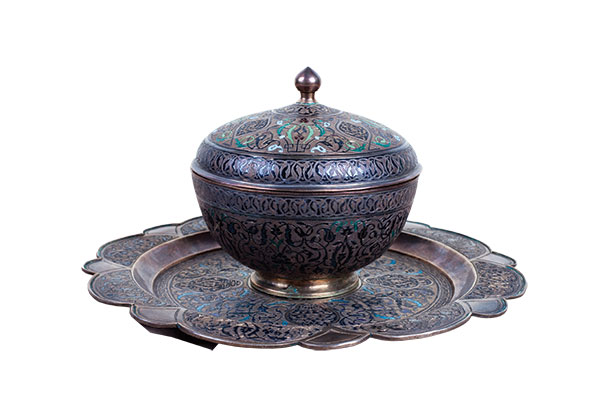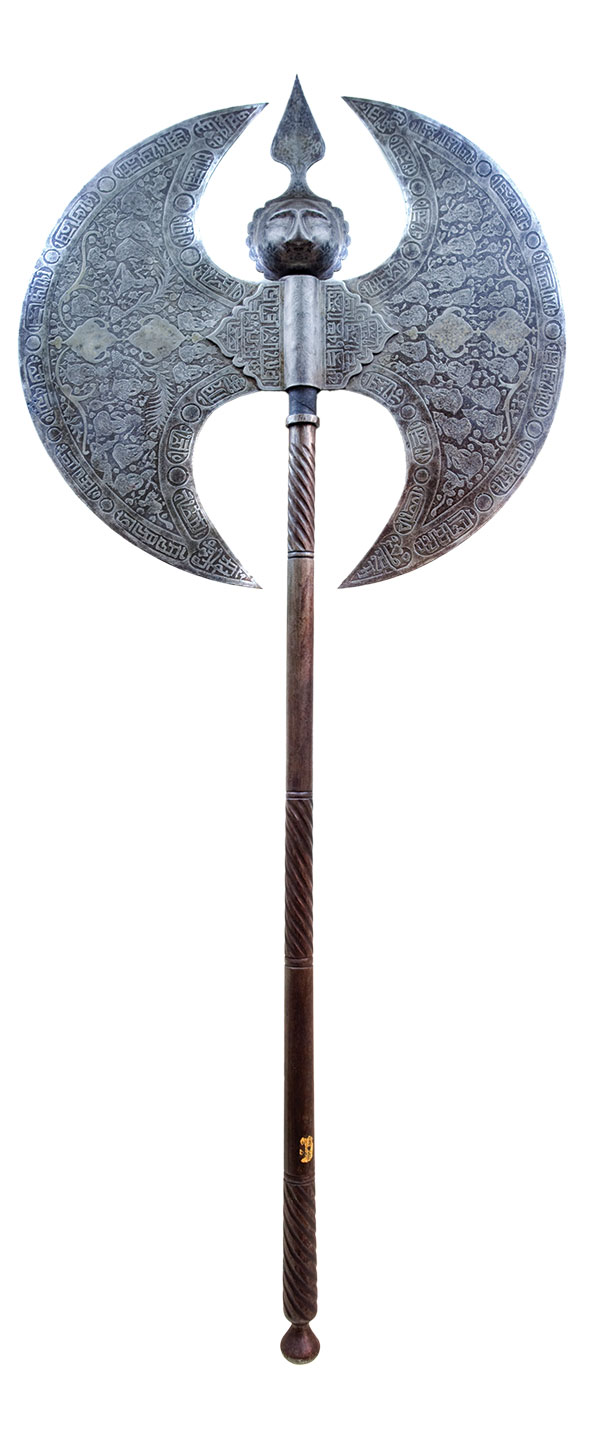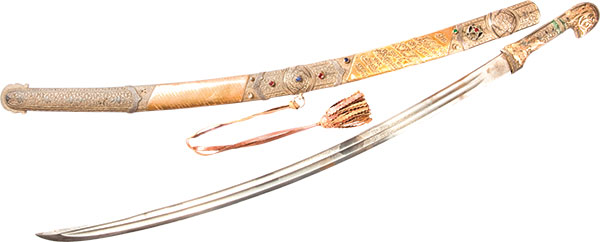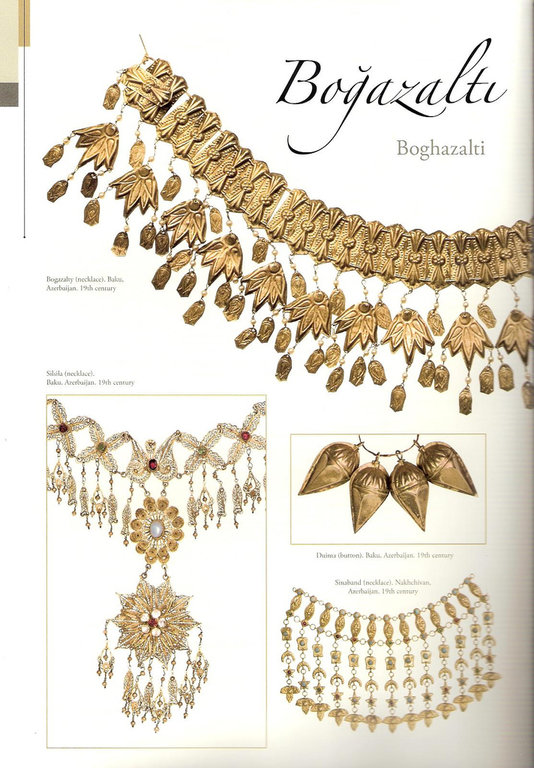Azerbaijan folk art has very ancient and rich traditions.

The work of arts made of metal mined in Nakhichevan, Mingechevir, Gedebey, Gazakh, Ganja and other regions are 5000 years old. Kitchen utensils, weapons and samples of accessories found in these areas should not only be treated as a historical fact but also as an important source which gives important information about mastership of the craftsman.
Copper, after its discovery in Azerbaijan in the period of eneolit plays an important role in the economic, agricultural, social and cultural life of the people of. After the discovery of lead, tin, manganese in Azerbaijan we experience the new and progressive age-the beginning of bronze age.
Material-cultural finds revealed during archaeological digs in Azerbaijan inform that our in the II millennium b. c. our predecessors widely used in their everyday life plates, delicate in form, daggers, axes, belts and other accessories made of bronze.
In spite of accurate elaboration and original forms bronze handicrafts made at this period were made without design. Among those monuments of the original form and accurate elaboration, we may name the figure of double-headed bronze deer found in village Dolanlar of Karabakh. In the past metal was generally used for the creation of artworks of religious character and it is possible that the deer was a totem the people of the whole territory worshipped.
Among bronze works of art of the ancient period, belt carries a particular importance for its high artistic value and mastering. The bronze belts revealed at the territories of Karabakh, Gazakh, Gedebey and other regions are striking with zoomorphic descriptions and designs on them.
Among works of art made of metal, one may found the patters with designs and descriptions on them, according which we may be informed of traditions, beliefs and clothes of that time population. Sealed bronze rings of the VIII-VII century b. c. found in Mingachevir tracts a great deal of attention. Described on the seals a man fighting with a lion, a fighter with a shield and a spear and a man worshipping the fire forms an idea of that time clothes and traditions.
The interesting point is that Strabon (63-19 b.c.) in the information given about the population of Caucasus mentioned the same clothes, weapons and everyday life implements here described. Metal processing at those times reached its high level in South Azerbaijan.
This is proved by samples of jewellery found in South Azerbaijan during archaeological digs.
Rare samples of art found in Hasanli, Garatepe, Ziviye and other places, located 70 km far from the lake Urmiya, are not only important materials about the history and the culture of ancient Azerbaijan, but they may also serve as an 'important document' which helped to solve the problems concerning the development of cultures of the Near and the Middle East.
Among works of art demonstrated in the museum of Archeology in Tehran gold basin, found from Hasanli hill draws particular attention. The descriptions on the basin are placed in two and three lines and cover the whole of it. The gold basin was found by an American archaeologist Robert Dayson, who resting on the descriptions refers the basin to the IX-VIII century b.c
Gold apron found in region Ziviya near the lake Urmiya, dated to the VIII-VII centuries b.c. proves the relation of the culture of Azerbaijan with neighbouring states. The apron is decorated with descriptions of a lion, a ram, a dog, a rabbit and a creature with a human head and lion body with wings.
Among lively descriptions on the gold apron, special attention should be paid to the figure of lions with a human head. Or their general appearance, composition and style of elaboration they remind animals 'Shedu' raised in front of the palace of II Sargon in ancient Assuria. We must point that the monuments were raised in VIII-VII centuries b. c. All this also prove the development of Azerbaijan culture.
The middle ages are the richest period in the history of Azerbaijan folk arts. Among everyday implements of this period kitchen utensils, found during archaeological digs in Mingachevir and kept in the Museum of Azerbaijan History in Baki are especially important. Among those utensils, silver plates are specially distinguished with their delicate designs and beautiful forms. Constantly repeated lines-relieves make the plate more interesting. As bas-relieves, they reflect the light and the shade and thus composes the whole thing. Delicate aftafa (a jug used for ablution)kept in the museum of Azerbaijan History was also decorated in this style.
Among traditional everyday implements, we man mention bronze tray (mejmei) found in Dagestan and in present-day kept at the Hermitage in Saint-Petersburg. The descriptions of lower, bows and their general composition on the tray made by forging are considered for its original style to be the pattern of the VI-VII century. Ornamental motives of plants are described on a great medallion in the centre of the tray
Not only everyday implements were made of metal by Azerbaijan masters, but tender pieces of jewellery as well.
Parts of gold and silver belts, rings, bracelets and other accessories found during archaeological digs in plain Mil, Gabala, Mingachevir, Nakhchivan and other places show that jeweller's art in Azerbaijan was in a high level of its development even till the beginning of the middle ages. Those works of art decorated by most difficult techniques of jewel's art: shebeke (tracery), basma (blotting), gelem ishi (pen-work)and others are characterized with the original form and delicate elaboration.
The interesting fact is that designs on the works of art of that period, for example, crescent, five-point star and other motives remained up to our days and are used by masters even today.

The XI-XV centuries are characterized by the process of the high development of the art of metal in Azerbaijan. Many weapons, house equipment of different shape and other samples of art were made during this period, most of them remained till our days. As in the past, Ganja, Shamakhi, Nakhchivan, Tabriz preserved their fame as the centres of metal products. Archaeological digs prove that in the XII century and later Baki also occupied a particular position in that sphere.
Among metal monuments made at that period the most attractive one is bronze Shirvan tube (lulak), the work of 1206 kept in the State Hermitage in Saint-Petersburg. It is difficult to understand at first sight that it is a water bowl. As it is composed of the monuments of small animals. The composition is created in the format stylization. The surface of the bronze tube is decorated with silver in the techniques of scratching and cyclization. Among the ornamental designs of Shirvan tube, one may notice historically-important scripts. One of the scripts reflects the name of the master of the tube -'Ali Mahamed oghlu'.
Metal equipment found together with the works of art of that period also draws particular attention. Those samples were revealed in the result of archaeological digs in of reservation of Shirvanshah palace in Icherisheher(the Inner Town). Bronze figurative lamp found among the same metallic samples.
The lamp is thoroughly covered with different descriptions in the technique of bas-relieve. Those are the real descriptions of a horse, two bulls, fourteen heads of cats and two human faces.
Bronze brazier of the XIII-XIV centuries found in the region of Guba may also be referred to monuments of Shirvan area. It has the form of half-sphere, the height is 30 cm, the length at its mouth is 131 cm, the diameter is 41 cm and original form and ornamental designs. The scripts on the brazier say that it was made by a copper-smith Ahmad Mahammad oghlu. The cities of Azerbaijan such as Beylagan, Ganja, Nakhchivan and Tabriz were main centres of the art of metal of that period.
It also proved by works of art revealed at those regions in the result of archaeological digs. Among works of art referred to these zones bronze monuments of a human and birds, found in Beylagan(Oran-gala) bronze can be made by Osman Salman oghlu Nakhchivaniin 1190 and kept in Luvr in Paris attract much interest.
As it is seen from named patterns the majority of metal implements used in everyday life were made of bronze.
Metal art was particularly developed in Tabriz in the XIV-XV centuries. Famous traveller of Venice Marko Polo, visited Azerbaijan in the second half of the XIII century spoke about the hugeness of Tabriz and the position, it occupied in development different spheres of the art. Today many prominent museums of the world exhibit a lot of original patterns of metal art made in Tabriz at this period of time. A figurative bowl made by Yusif ibn Ahmed Tabrizi in 1319, kept today in Victoria and Albert Museum of London and a bronze tiyan, kept in the State Hermitage of Saint- Petersburg should especially be mentioned.
it occupied in development different spheres of the art. Today many prominent museums of the world exhibit a lot of original patterns of metal art made in Tabriz at this period of time. A figurative bowl made by Yusif ibn Ahmed Tabrizi in 1319, kept today in Victoria and Albert Museum of London and a bronze tiyan, kept in the State Hermitage of Saint- Petersburg should especially be mentioned.
Tiyan made by Abdul Aziz Sharafaddin oghlu in 1399 in Tabriz is the most interesting work of art among those reflecting national traditions of the mentioned period. With the weight of 2000 kg and a diameter of 2.45 sm this work of art is considered to be the greatest tiyan known in the East World. Tiyan draws attraction not only for its incomparable size but also for its artistic construction. On the front part, tiyan is decorated with beautiful designs of plants. Among the designs, there is a script about that the monument was made by Abdul Sharafaddin oghlu in 1399 in Tabriz on demand of Teymurleng for the mosque Khoja Ahmad Yasevi. One may also find the script 'The ruler of the world is Allah' one after another 22 times repeated along with the whole kettle.
There is the specimen proving that Tabriz was not the only centre of metal art, as during and after that period this kind of art was also developed in other cities of Azerbaijan. Today Mr. Harari, keeps in America in his personal collection an original bronze istirlab, referred to the XV century. According to notes made on this tool, used in astronomy, it was made by the famous master of Shirvan Shukrullah Mukhis in 1468. Being a highly technical instrument, this istirlab amazes with designs on its surface.
In the XVI-XVII centuries preparation of metal house equipment, weapons and accessories were especially developing in Tabriz, Ardabil, Maraga, Nakhchivan, Ganja, Shamakhi and Baki. Weapons (daggers, swords, topuzes and shield) and armoured clothes(bashlyk(hood),elbow-rest, breeches) made by masters of Azerbaijan were very famous abroad at that period.
In Russian sources, we often come across the names of weapons made in Shamakhi. In one of such materials, we learn about 8 decorated hoods of Russian tsar Boris Godunov, made by the masters of Shamakhi.

The fame of Azerbaijan weapons at that time was not accidental. Local masters invaded many new ways in the preparation of the weapons.
The XV century replaces so well known straight and wide swords with a crook crescent-like swords with the handle made of gold, silver and valuable bones.
The appearance of shields and armoured clothes were richer and more magnificent than before.
A shield referred to the XV century kept in the house of weapons of Kremlin draws particular interest. With its amazing beauty, this shield protected a Russian tsar M.F.Romanov during the war. Then it passed to famous Russian warlord F.I.Mstislavski, and in 1622 after his death, was presented to the treasury of Russian tsars. Its diameter is 50,8 cm, was forged of the whole red steel and covered with gold by the technique of khatemkarlig.
We may stress two more samples made in Azerbaijan at that period. both of them are the hoods used by the nobles during wars. One of them is now kept in Moscow House of weapons, the second is kept in Istanbul. The second hood carries a script, noting that it was made for Shah Tahmasib in 1528.
The first armoured hood is first named in the list of weapons brought to Boris Godunov from Shamakhi. Later this helmet was kept as a figurative pattern by knyaz (prince) F.Mstislavski.
The abovementioned sample is so filled with decorations that it nearly looks like an arakhchin with gulabatin needlework, then a hood protecting the head from the stab of the sword, mace and so on.
One may notice the samples of calligraphy among decorations of the hood. They are placed in a wide range on the forehead of the hood. They are the words: 'For the sake of powerful and merciful Allah'.
The hood was made of smoothed steel and decorated by means of three techniques of metal processing: tracery (shebeke), khatemkarlig and pen work.
Jewels may be referred to as an inseparable part of samples of metal art of the XVI-XVII centuries. They were generally made of gold and silver and used as accessories for men and women.
The golden and silver accessories made of precious metal were of 4 kinds according to their usage: 1-accessories for neck, 2-those for arm and fingers, 3- for the head,4- and those attached on the clothes.
Two work should be mentioned among the jewellery made in this period and preserved up to our times. One of them is a silver decorated necklace in the form of almond and corns of pomegranate found among Safavi coins during archaeological digs in region Gedebek, the second one is the gold waistband of I Shah Ismayil referred to 1507.
Shah Ismail's waistband is of particular interest. Today it is kept in the palace of Topgapi of Istanbul and considered one of the richest and most decorated among all the waistband for men. Ornamental designs of the plant on the waistband are alike those met on the carpets, cloths and other works of art of the period. The most beautiful part of the waistband is its belt. Being in the form of a circle, the belt has the real descriptions of a young noble on the horse going for hunting and a guide accompanying him.
According to general composition and separate motives descriptions on the belt remind of some subjects in the art of miniature of the time.
The most developed sphere of art developed in the XVIII in Azerbaijan was the coppering. Foreign travellers inform that special streets of coppering were in the cities of Tabriz, Ganja, Sheki, Shusha, Shamakhi, Baki where masters made decorated, original kitchen implements.
There were zones in Azerbaijan where the major part of the population was busy with that sphere of art. One of such places was Lahij, included in the khanate of Shamakhi at that time.
Everyday life and house implements (such as can, satil, aftafa, sernij, copper tray (mejmeyi), serpuz, etc.) were made in Lahij at the period. Products of Lahij was as well in quality and quantity as the products made in central cities of that time.
Among preserved up today metal products made in Lahij samovar of the XVIII century carries particular interest. Its has correct proportions, beautiful form and decorations on it. The decoration consisted of stylized descriptions of plant, zoomorphic and human. The majority of designs used in the decoration of the samovar are found on many samples of Azerbaijan folk art(i.e. on walls and stones, cloths, fancywork, etc.). The samovar was made of copper and decorated by the settler of the village Lahij, a copper-smith master Najafgulu in 1130 according to the calendar of hijri-gamary (in 1717 according to the calendar of Christianity).
Sheki also was among those popular for the production of metal house equipment and accessories in the XVIII century.
As to the sources, the masters of Sheki were famous for making cast decorated brazier.

Those braziers were not big in size. Majority of them consisted of 6-8 cast bronze parts hooked to each other with. On those bronze pieces, you may fund the ornaments of plants, geometric figures, and figures of birds and animals worked by bas- relief.
The composition of 'Islimi', a curved line with attached flowers and leaves was the popular one among plant designs, as well as the figures of nightingales and lions faced each-other.
Many of the patterns of the jewellery of the XVIII century had been preserved up today.
The most popular women accessories used by women were necklaces. Among them were sinebends, bogazaltis, chechiks, garabatdags and others.
Those accessories were made by attaching valuable beads, purls or pieces of gold and silver in the form of pakhlava(rhomb). In the majority of the cases or better look of those accessories, around the second part with the description of the net on it was attached to it to cover the chest. Sometimes this circle was replaced with a 6, 8 or 12 point star, worked in the technique of tracery, galam ishi or other, in the centre of which there were ruby or turquoise and a crescent under it.
Two same woman head-dresses, kept in the museum of country-studies in Zagatala are among the best patterns of jewellery made in this century.
At first sight, the abovementioned head-dresses look like a helmet.
The bashlig (hood) is composed of silver pieces of different form and size attached to each other by means of circles. In order to be far from monotonousness decorated with precious jewels, round plates are placed between the silver pieces. They are placed at the sides and at the top of the bashlig. The most beautiful part of bashlig is a tender figure of a crescent and star attached to the tube raising up off its top.
The waistbands made for women and men made at this period of time again prove that the patterns of jewellery were related to old traditions.
In the past waistband was an inseparable part of women and men clothes, which might give the information about the position, wealth, religious belief, nationality and age of its owner.
The waistband in the XVIII century was used both by men and women. The waistband for women was wide, while that for men was thin.
The waistbands of this period were made of figurative and decorative pieces of bronze, silver and gold. The most beautiful part of them were the belts. The belts generally were in the form of square metal decorated in the technique of shebeke (tracery), gelem ishi (pen-work)and sometimes decorated with precious jewels. Women attached 23 lines of gold and silver coins or the accessories in the form of buta or pakhlava (rhomb) to the lower edge of the waistband when men attached several decorated with different figurative metal pieces thongs hanged over the lap
One of the popular kinds of waistbands in Azerbaijan in the XVIII century was 'cherkezi kemer (waistband)' for men. In some cases those waistbands had metal figures of pakhlava, circle and sometimes horses and rams facing each other and other samples decorated by the technique of garasavad and blotting.
House equipment, weapons, accessories made of metal in XVII century Azerbaijan were decorated by 6 techniques: forging, blotting, garasavad, shebeke (tracery), khatemkarlig (ring-making) and minachilig (glaze-covering).
Forging is one of the ancient techniques. It the easier than other techniques of the art. It demands sharp eyesight and great skill. The masters work with hammer and sharp-tip tools.

In the technique of blotting a piece of gold, silver and any other precious metal is placed on a high mould with decoration or design in the form of relief. Then the piece of precious metal is covered with a piece of lead of the same size and the masters begin to strike on it with a wooden hammer and the precious metal takes the necessary form. This kind of technique is generally used in making of the waistbands, buttons, bracelets and others.
Garasavad was mainly applied on silver, for in dark tone silver gets clear and white lines. On the surface of forged smooth silver masters drew come description by means of scratching and covered its sides with a black substance. Generally, the accessories(waistbands, daggers, pistols, gun powder-boxes and others )were decorated by this technique.
Shebeke is the description or a design made by a thin winding string. Two forms of shebeke are known: the first constitutes the thing with gold and silver strings, the second decorates the same thing.
Khatemkarlig has a great heritage in the jeweller's art o Azerbaijan. To decorate dagger, swords and other samples of art the surface of the thing is slightly drilled by cheshni, appeared holes are filled with gold, silver and other non-ferrous metal nails. After the process is completed, the surface of the thing is smoothed and gets the form of a beautiful mosaic.
One of the most difficult and interesting branches of this technique is scraping a script or a picture on the thing with non-ferrous metals. The master should have great taste and skill to do it. Azerbaijan artists were very skilful in that sphere of art.
Minachilig was one of the ranches of the art which took Azerbaijan jeweller's art to its highest level. Perdeli mina as one of the difficult and interest braches of minachilig, was widely spread in Tebriz, Nakhchivan and Baki.
The technique of this branch of art is to fill an engraved picture or a design with colourful liquid(glaze) named mina. Users of this technique by means of blotting copied the design (bird, animal, plant, etc.) described on the mould on to a piece of gold, silver and other metal and filled the spaces with mina.
The most frequently used colours in minachilig were rosy, green, blue, turquoise, black and red.
In comparison with minachies of the other countries, the works of minachies of Azerbaijan were the most popular ones, for they did not use mixed or muddy colours in their works. Each of the colours used by them to fill in the paces had their own peculiarities and were separated from each-other with a golden or another sting. Majority of colours in Azerbaijan minas and the harmony between them strikes everyone.
At the beginning of the XIX-XX centuries, 3 kinds of metal art were developing in Azerbaijan. They were the profession blacksmith, coppering and jeweller's art. The blacksmiths made the agricultural tools and everyday equipment: a brazier, tripod, door handle, tongs and others.
The art of coppering having a great heritage in Azerbaijan was preserving its particular place during those ages. Depending on the peculiarity of everyday life and their economic engagement of people of Azerbaijan there was a great need in the country for a pot, a pan, a serpush (plate cover to keep the food hot), a sernish (milking), a tray, a satil (bucket), an aftafa, a seheng(a long jar with long neck to carry water), a can and other things made of copper
In comparison with other samples of metal art, jeweller's art preserved the traditions of the past. Rings, earrings, bracelets, sinebends (collars), waistbands and others used by Azerbaijani women were again in fashion.
Minali earrings made by jeweller's of Baki and Shamakhi, the accessories for neck and chest made by the masters of Ganja and Sheki in the technique of shebeke and decorated with jewels gold combs, glassy waistbands made by Shuha masters still amaze everyone.
By the way, Lahij was included in the UNESCO Intangible Cultural Heritage List in 2015.



